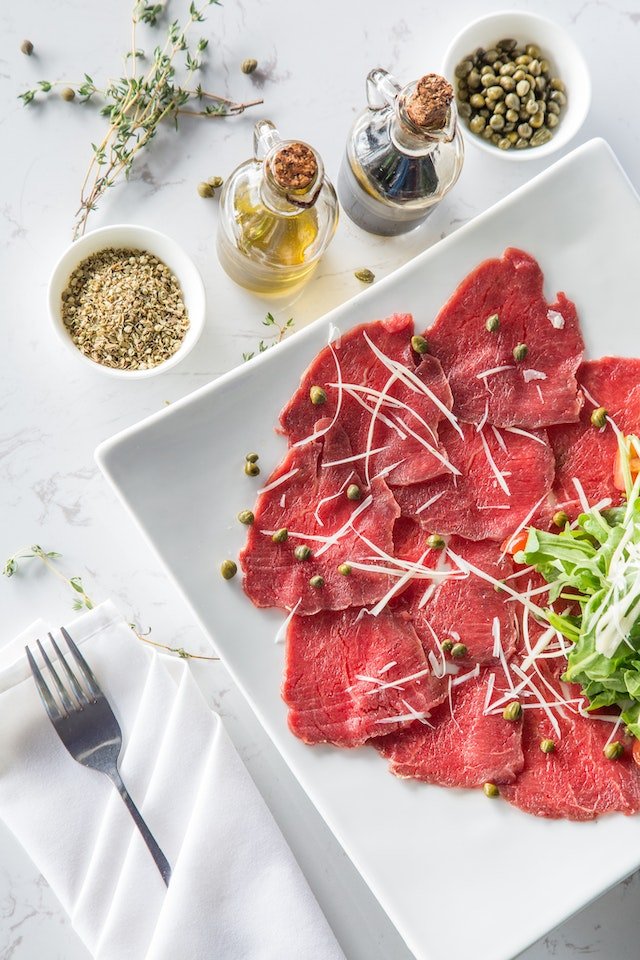From Failures to Perfect Loafs: Why Sourdough Is More Than Just Bread
Hello, fellow bread lovers! I’m Ksenija, a nutritionist and chef with over 15 years of experience, and I’ve spent the last five years baking sourdough bread at home.
Trust me, it hasn’t always been a smooth ride! From failed loaves to over-proofed dough, I’ve had my fair share of “oops” moments. But that makes sourdough so special: the journey of learning, adjusting and finally achieving that perfect, tangy loaf.
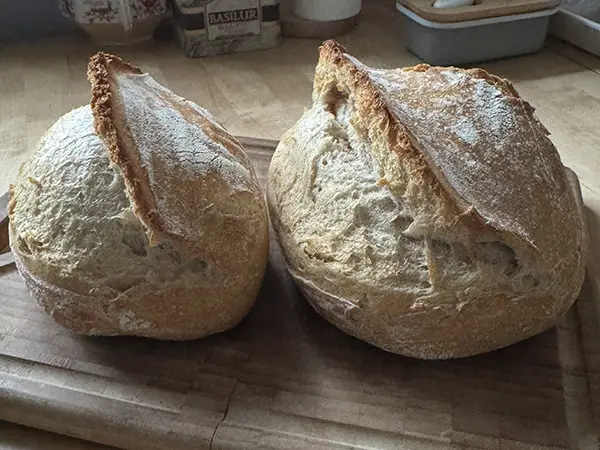
Sourdough isn’t just any bread. It’s a bread with character, flavour, and a whole lot of health benefits that most people don’t realize. Unlike store-bought bread, sourdough is naturally fermented, which means it’s easier to digest and filled with probiotics and nutrients that support your gut health.
In this post, I’m going to share with you why sourdough is so unique, what makes it a healthy choice, and why you should try it out. Let’s dive in!
What is Sourdough?
Sourdough is a type of bread that’s made using a natural fermentation process, unlike most breads that rely on commercial yeast. It uses wild yeast and lactic acid bacteria, which are naturally present in the environment (and your starter). These microbes work together to help the dough rise and create that signature tangy flavour and chewy texture that makes sourdough stand out.
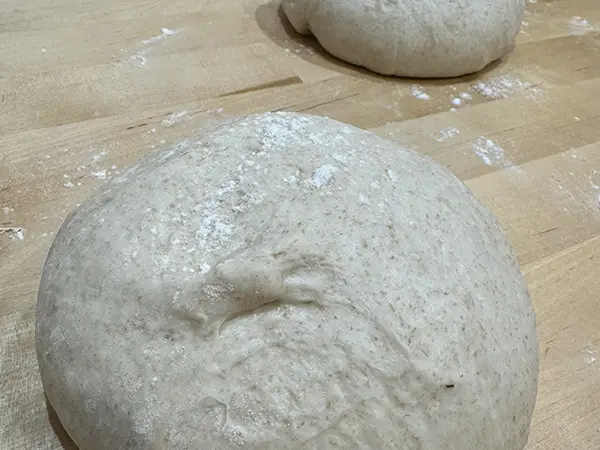
What makes sourdough different from store-bought bread is that it doesn’t require added yeast. The wild yeast in sourdough comes from the air around us, flour, and even the environment in your kitchen! This means that each loaf you make (or buy from a local baker) will have its subtle flavour profile based on the local yeast strains and conditions.
How Does Sourdough Work?
Sourdough starts with a simple mix of flour and water to create a “starter”—a living culture full of wild yeast and bacteria. Over time, these microorganisms feed on the flour’s sugars, producing carbon dioxide, which makes the dough rise. The bacteria also release lactic acid, giving sourdough its signature tangy flavour.
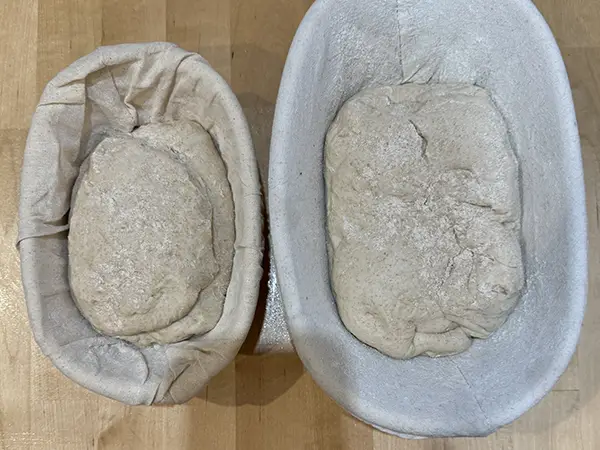
Because the fermentation process is slower than with commercial yeast, the dough has more time to develop rich, complex flavours. The result? A soft, chewy texture and that distinctive sourdough taste we all love!
A Brief History of Sourdough
Sourdough is one of the oldest methods of bread-making, with its origins dating back thousands of years. The first loaves of bread were likely made with wild yeast before anyone even knew about commercial yeast! Ancient Egyptians are credited with discovering the fermentation process, and it spread through the centuries as cultures developed their variations of sourdough.
In the U.S., sourdough became particularly famous during the California Gold Rush in the mid-1800s, when miners relied on sourdough for its long shelf life and ability to be baked without access to modern ovens. To this day, sourdough is still a beloved tradition, especially in places like San Francisco, where the unique local yeast strains give their bread a distinct flavour.
The Health Benefits of Sourdough
Better Digestion
One of the biggest perks of sourdough is how it makes bread easier to digest. Thanks to the long fermentation process, the wild yeast and bacteria help break down gluten, making it gentler in your gut. This can be especially helpful for those with gluten sensitivity (though not for those with celiac disease). The longer the fermentation, the easier it is to digest!
Lower Glycemic Index
Unlike most white breads, sourdough has a lower glycemic index (GI), which means it won’t spike your blood sugar as quickly. This is great for people managing blood sugar levels, like those with diabetes or anyone looking for a more balanced energy boost. The slow fermentation process helps regulate how the sugars in the bread are absorbed into the bloodstream.
Probiotics (Sort Of!)
Because sourdough is naturally fermented, it contains beneficial bacteria—aka probiotics—that are great for gut health. However, keep in mind that most of these probiotics don’t survive the baking process (due to the high heat). But, the fermentation still provides some prebiotics (fibre that feeds good bacteria in your gut), which is a win for your digestive system!
The Sourdough Craze
Why Sourdough Became Popular During the Pandemic
Let’s be real: when the pandemic hit, we were all looking for ways to feel connected and productive. Enter: sourdough. Suddenly, it wasn’t just about making bread—it was about creating something with your hands, connecting with a centuries-old tradition, and even finding some comfort during chaos. The long process of nurturing a sourdough starter became almost therapeutic. Plus, who could resist the satisfaction of pulling a perfectly risen loaf out of the oven? It was the ultimate “I did this!” moment!
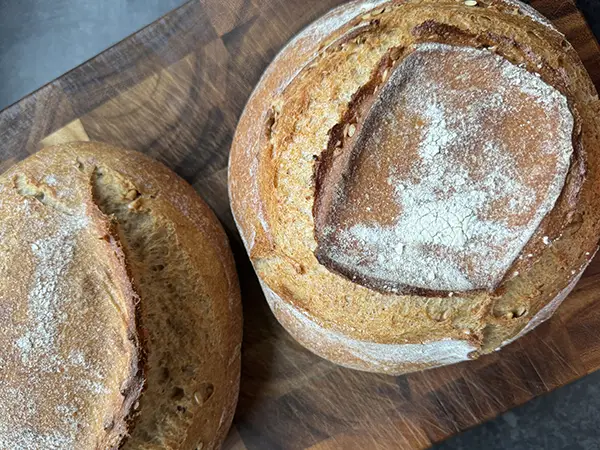
Today, sourdough is more than just a pandemic trend—it’s part of a bigger movement back to real, homemade bread. People are rediscovering the joy of baking from scratch and appreciating the artistry behind every loaf. As folks look for healthier, locally-made options, sourdough is making a strong comeback in kitchens and bakeries everywhere. It’s all about quality, flavour, and tradition—and it’s definitely here to stay!
Personal Sourdough Journey
My sourdough journey started about 5 years ago, and, honestly, it wasn’t love at first loaf! I was excited to bake, but my first few attempts were a disaster. My starters didn’t thrive (rest in peace, little guys), I had no clue how the chemistry of it all worked, and I was just blindly following YouTube recipes like a recipe robot. Spoiler alert: it didn’t go well. Unrisen, flat loaves became my specialty!
But then something shifted. As I started studying nutrition, I got more curious about the health benefits of sourdough, and it became a challenge I wanted to conquer. So, I threw out the YouTube guides and started experimenting with different recipes, learning about the science behind the fermentation process. I figured out what worked and, after some trial and error, I finally created my sourdough recipe. Success! A beautiful loaf that rose!

Now, I’m obsessed. There’s nothing better than pulling a warm, golden loaf out of the oven, the smell filling the kitchen. Honestly, I prefer eating sourdough to store-bought bread—it’s tastier and healthier, and I love the fact that it’s made from scratch with love (and a little bit of science).
And you know what? I’m so passionate about sharing this experience with my local community. I want people to understand why sourdough is so much more than just bread from a supermarket. It’s full of flavour, history, and health benefits—and when you buy it from a local baker (like me!), you’re getting something that’s crafted with care. So, if you’re tired of bland, mass-produced bread, come grab a loaf of my homemade sourdough. Trust me, it’s worth it!
Wrap-Up
So, there you have it—sourdough is more than just a loaf of bread; it’s a journey of flavour, tradition, and health benefits. From its unique fermentation process to its amazing digestibility and tangy goodness, sourdough is truly in a class of its own. And trust me, I’ve been through the ups and downs of sourdough baking myself, from failed starters to finally perfecting my recipe.
And if you’re hungry for some tasty and nutritious recipes, don’t forget to check out my other chicken recipes on the blog. There’s plenty more to explore and enjoy!
Together, let’s continue transforming our health and palate, one bite at a time! See you soon!






